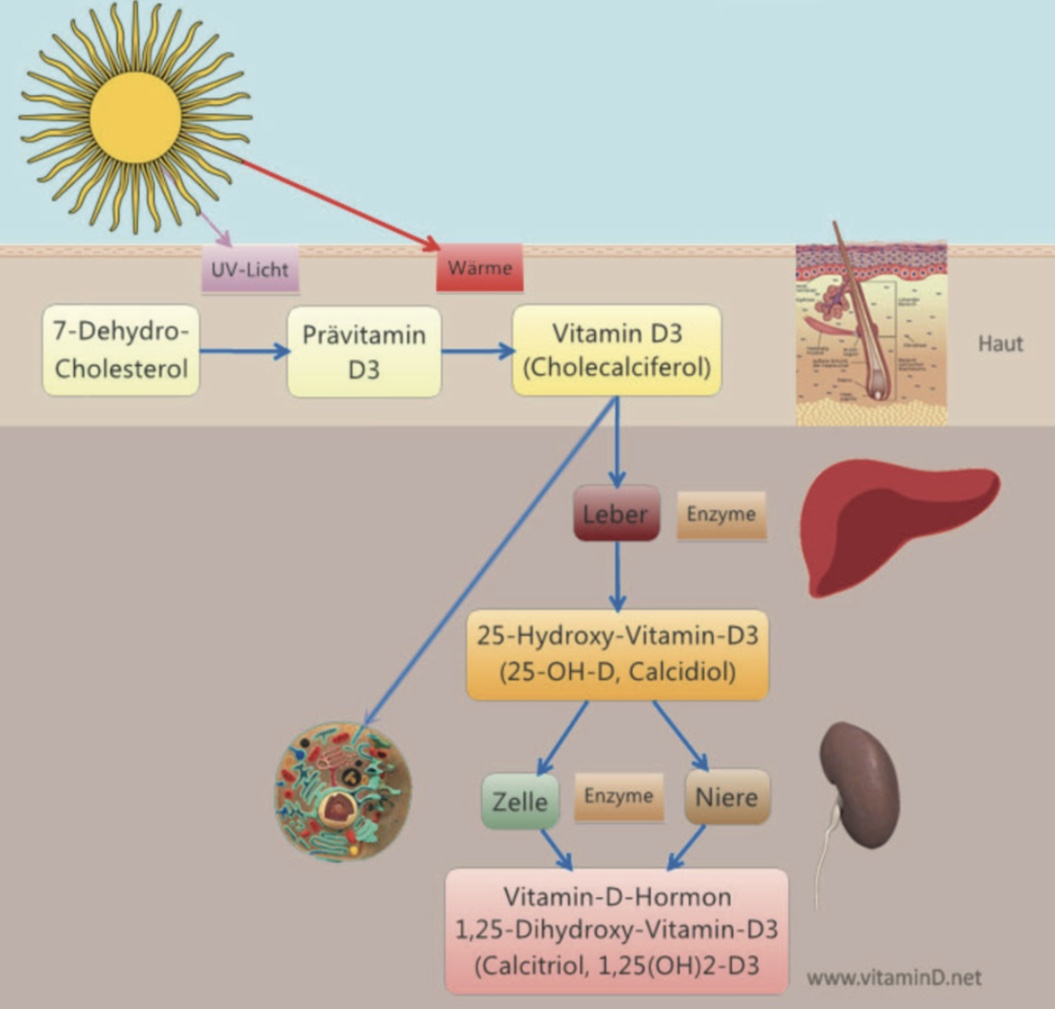This is a great explanation of the importance of vitamin D3 from our Swiss Biohealth D3 leaflet.
importance of vitamin D3
The final stage of vitamin D3 in the cell is a hormone called calcitriol, which together with parathyroid hormone (PTH) is one of the most important hormonal controls of calcium and phosphate content. The parathyroid hor- mone secreted by the parathyroid gland is released when the calcium level sinks. It activates the osteoclasts („bone-eating cells“) indirectly and mobilizes calcium and phosphate from the bone tissue. The consequence is an increased calcium level in the blood and a reduced content of minerals in the bones (osteopenia, osteoporo- sis). The synthesis and release of PTH is inhibited by calcitriol. Calcitriol reduces the excretion of calcium from the kidneys and increases the available calcium through absorption in the small intestine. This leads to an increa- sed osteoblast activity; the ability to form healthy new bone.
A study (see Choukroun et al 2014) shows the importance of vitamin D3 in bone formation on which implant healing depends. 1,25- (OH) 2-vitamin D3 (= calcitriol) is the most important hormone involved in bone formation and at the sametimeitreducesinflammation.i LackofvitaminD3 inhibits the healing of implants and increases the risk of infection. ii
Furthermore, an anti-inflammatory effect on the gums and the periodontium is proven. Activated vitamin D3 stimulates the formation of antimicrobial peptides on the skin and mucous membranes and therefore has an antibacterialandanti-inflammatoryeffect.iii (Hieremath, 2013).
A study from 2016 (see. Woelber et al.) proves that a diet low in carbohydrates, while at the same time satisfying
the need for omega-3 fatty acids, fiber, vitamins C and D as well as antioxidants, can prevent gum and dental inflammation.
Therefore, periodontitis no longer needs to be treated surgically. It can be prevented and treated by supplemen- ting the needed vitamins and minerals. A study from 2012 (see F.R. Teles et al.) shows that patients with high vitamin D levels had significantly fewer bleeding gums, less pocket depths and less tooth loss. v
In addition to the importance of calcium metabolism and bone formation, vitamin D3 has immunological and metabolic effects on our body. Autoimmune diseases such as multiple sclerosis, arthritis and diabetes are more common with low D3 levels. vi With sufficient vitamin D3 formation, the acquired (in the case of autoimmune diseases overactive) immune response is regulated down, and the innate non-specific immune response is regulated up. Receptors for vitamin D3 can be found in some cell types of our immune system, i.e. in T lymphocytes and T helper cells. In experiments, the elimination of these receptorsledtoinflammatorygutdiseases.vii
Vitamin D3 also strengthens AMPs (anti micro biotic proteins). Those AMPs kill microorganisms, bacteria and viruses often faster and more effective than the immune system, which was gained through activation of speciali- zed defense cells.
The final stage of vitamin D3 in the cell is a hormone called calcitriol, which together with parathyroid hormone (PTH) is one of the most important hormonal controls of calcium and phosphate content. The parathyroid hor- mone secreted by the parathyroid gland is released when the calcium level sinks. It activates the osteoclasts („bone-eating cells“) indirectly and mobilizes calcium and phosphate from the bone tissue. The consequence is an increased calcium level in the blood and a reduced content of minerals in the bones (osteopenia, osteoporo- sis). The synthesis and release of PTH is inhibited by calcitriol. Calcitriol reduces the excretion of calcium from the kidneys and increases the available calcium through absorption in the small intestine. This leads to an increa- sed osteoblast activity; the ability to form healthy new bone.
A study (see Choukroun et al 2014) shows the importance of vitamin D3 in bone formation on which implant healing depends. 1,25- (OH) 2-vitamin D3 (= calcitriol) is the most important hormone involved in bone formation and at the sametimeitreducesinflammation.i LackofvitaminD3 inhibits the healing of implants and increases the risk of infection. ii
Furthermore, an anti-inflammatory effect on the gums and the periodontium is proven. Activated vitamin D3 stimulates the formation of antimicrobial peptides on the skin and mucous membranes and therefore has an antibacterialandanti-inflammatoryeffect.iii (Hieremath, 2013).
A study from 2016 (see. Woelber et al.) proves that a diet low in carbohydrates, while at the same time satisfying
the need for omega-3 fatty acids, fiber, vitamins C and D as well as antioxidants, can prevent gum and dental inflammation.
Therefore, periodontitis no longer needs to be treated surgically. It can be prevented and treated by supplemen- ting the needed vitamins and minerals. A study from 2012 (see F.R. Teles et al.) shows that patients with high vitamin D levels had significantly fewer bleeding gums, less pocket depths and less tooth loss. v
In addition to the importance of calcium metabolism and bone formation, vitamin D3 has immunological and metabolic effects on our body. Autoimmune diseases such as multiple sclerosis, arthritis and diabetes are more common with low D3 levels. vi With sufficient vitamin D3 formation, the acquired (in the case of autoimmune diseases overactive) immune response is regulated down, and the innate non-specific immune response is regulated up. Receptors for vitamin D3 can be found in some cell types of our immune system, i.e. in T lymphocytes and T helper cells. In experiments, the elimination of these receptorsledtoinflammatorygutdiseases.vii
Vitamin D3 also strengthens AMPs (anti micro biotic proteins). Those AMPs kill microorganisms, bacteria and viruses often faster and more effective than the immune system, which was gained through activation of speciali- zed defense cells.
I hope this blog post helped you – especially as winter is coming now and D3 gets even more important for our body! I wish everyone a good day, Coco


